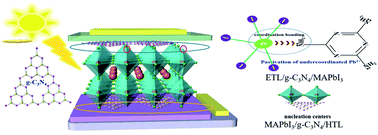The dual interfacial modification of 2D g-C3N4 for high-efficiency and stable planar perovskite solar cells
Abstract
Carrier recombination and charge loss at the interfaces of perovskite layers have a significant influence on high-performance planar perovskite solar cells (PSCs). We employed two-dimensional graphitic carbon nitride (g-C3N4), which is a heat-resistant n-type semiconductor, to modify the electron-transport layer/perovskite and perovskite/hole-transport layer interfaces, respectively. g-C3N4 could passivate the surface trap states of the methylammonium lead iodide light absorber through the formation of a Lewis adduct between N and the under-coordinated Pb, and it could also remarkably reduce the grain boundaries between perovskite crystal particles. A maximum power conversion efficiency (PCE) of 19.67% (Voc = 1.14 V, Jsc = 21.45 mA cm−2, FF = 0.807) could be obtained from planar PSCs with long-term stability using dual-positioned g-C3N4. Therefore, we consider that ultrathin semiconductor films with a Lewis base nature are suitable as dual-functional transport materials for devices. This work provides new guidance for dual-interfacial modification to improve the PCE and stability of devices.



 Please wait while we load your content...
Please wait while we load your content...